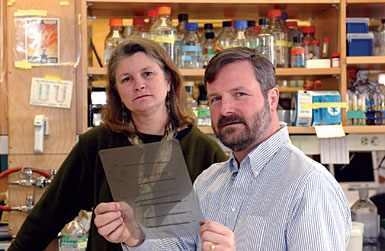Antisense DNA helps make sense of clock secrets
A trio of Dartmouth researchers —from two different DMS departments and from the College's biology department—have been working for years to unlock the secrets of biological clocks. Attacking the issue on several fronts are Jay Dunlap, Ph.D., a professor and chair of genetics; Jennifer Loros, Ph.D., a professor of biochemistry; and C. Robertson McClung, Ph.D., a member of Dartmouth College's biology department.
Genes: Dunlap and Loros (who are married to each other)— with a pair of British colleagues, including former DMS postdoctoral fellow Susan Crosthwaite, Ph.D.—recently discovered that an unusual form of RNA known as antisense appears to regulate core timing genes in the bread mold Neurospora's biological clock. And McClung, who was a postdoctoral associate in Dunlap's lab before establishing his own lab more than 15 years ago, has uncovered evidence of two circadian clocks working within the same tissue of the flowering plant Arabidopsis thaliana.
The DMS results, published in Nature, are important because they reveal how antisense RNAs might affect a wide variety of processes. The findings, write the authors, "provide an unexpected link between antisense RNA and circadian timing."
Usually, messenger RNA (mRNA) transcribes the genetic instructions contained in DNA, then translates the information to form a protein molecule.
But when a strand of mRNA forms a duplex with a second strand of RNA, the translation process is turned off. The first strand is called "sense" RNA, because it can normally be decoded to form a protein; the second strand is called "antisense," because its nucleotide sequence is the complement of the "sense" message. And this sense-antisense combination renders the sense strand incapable of decoding the DNA recipe to yield a protein product.
In normal bread mold strains, light triggers the cycles of antisense and sense RNA transcripts related to the frequency gene. But in mutant bread mold strains —ones that have been genetically altered to abolish light's ability to induce the antisense RNA—the internal clock time is delayed and the resetting of the clock by light is altered.
Stability: If similar environmental factors regulate both sense and antisense transcripts, the authors suggest, a role for antisense frequency RNA might be to confer the ability to keep accurate time by limiting the clock response to extremes in the environment. And other antisense RNAs might be involved in maintaining internal stability in other organisms.

|
|
Dartmouth Medical School researchers
Jennifer Loros and Jay Dunlap, pictured
below, have spent many years teasing
out the mechanisms of biological clocks. |
"Antisense RNA may play a role in regulation of clock genes in people," says Dunlap. "Misregulation of circadian clocks and their responses to light has been implicated in several kinds of mental illness or affective disorders. And misregulation of clock genes has been suggested as an origin of some cancers."
McClung, whose early work with Dunlap focused on Neurospora, is still looking at biological clocks but in different organisms now. His recent findings, published in the online edition of the Proceedings of the National Academy of Sciences, suggest that plants may respond to seasonal changes by integrating information from at least two environmental signals—light and temperature.
"This is exciting, because this is the first good example of two clocks operating within a single tissue in any multicellular organism," McClung says. "We're not quite at the point where we can find out if there are two clocks operating in a single cell, but that's our goal."
Much has been discovered about biological clocks over the past 30 years, since Dunlap gained recognition for identifying what he calls the clock's "cogs and gears."
Findings: Last year, Dunlap's lab revealed that a single protein called White Collar-1 does double duty: it perceives light and it also turns on the central component of the clock, the frequency gene. Other findings made at DMS include the discovery that temperature may be more influential than light in setting cells' biological clocks and that signals tell bread mold when to send out spores, delineating how the clock is assembled and how light resets the biological clock.
How much else is there to discover about circadian clocks?
"Who knows," says Dunlap.
Laura Stephenson Carter
If you would like to offer any feedback about this article, we would welcome getting your comments at DartMed@Dartmouth.edu.
